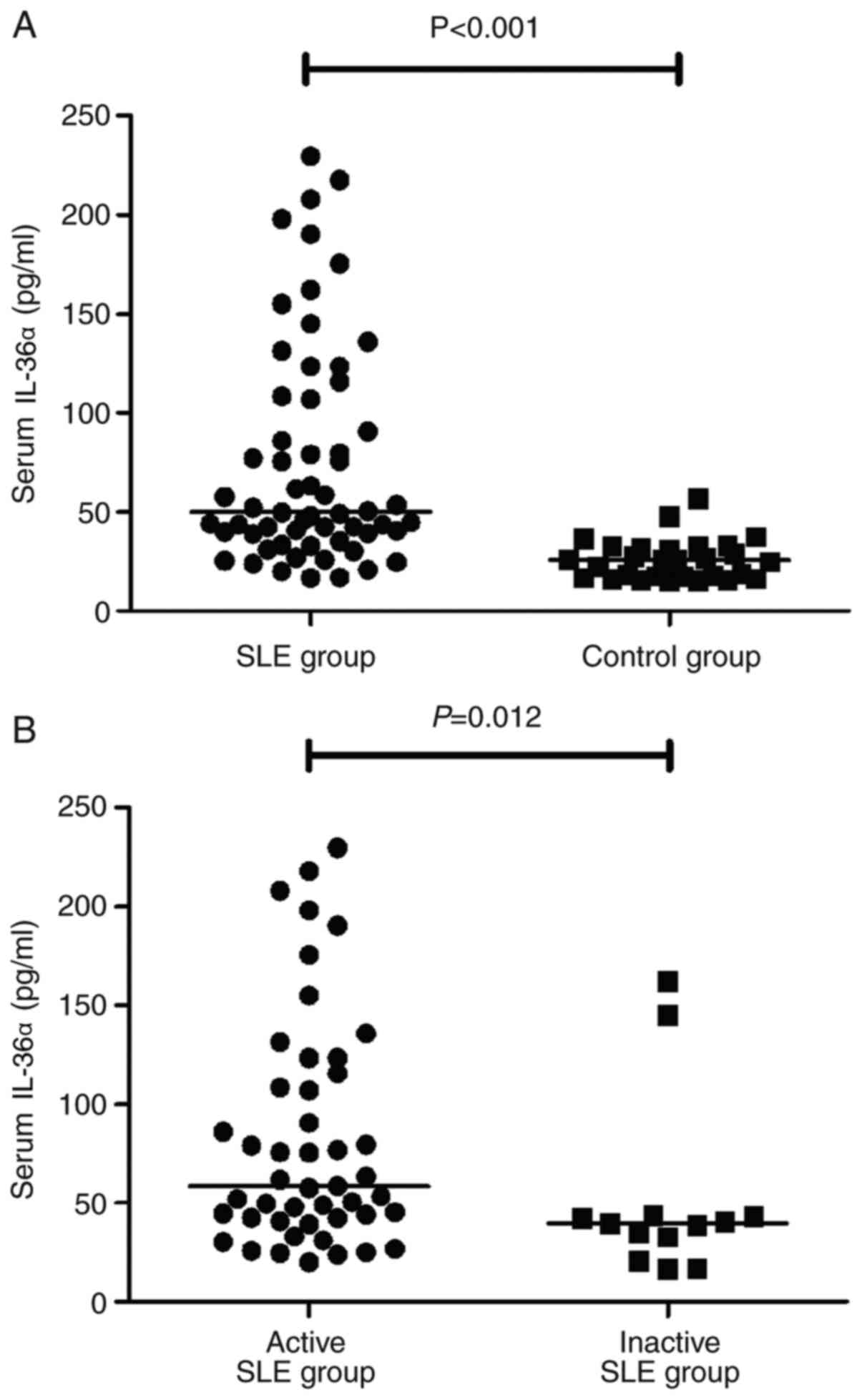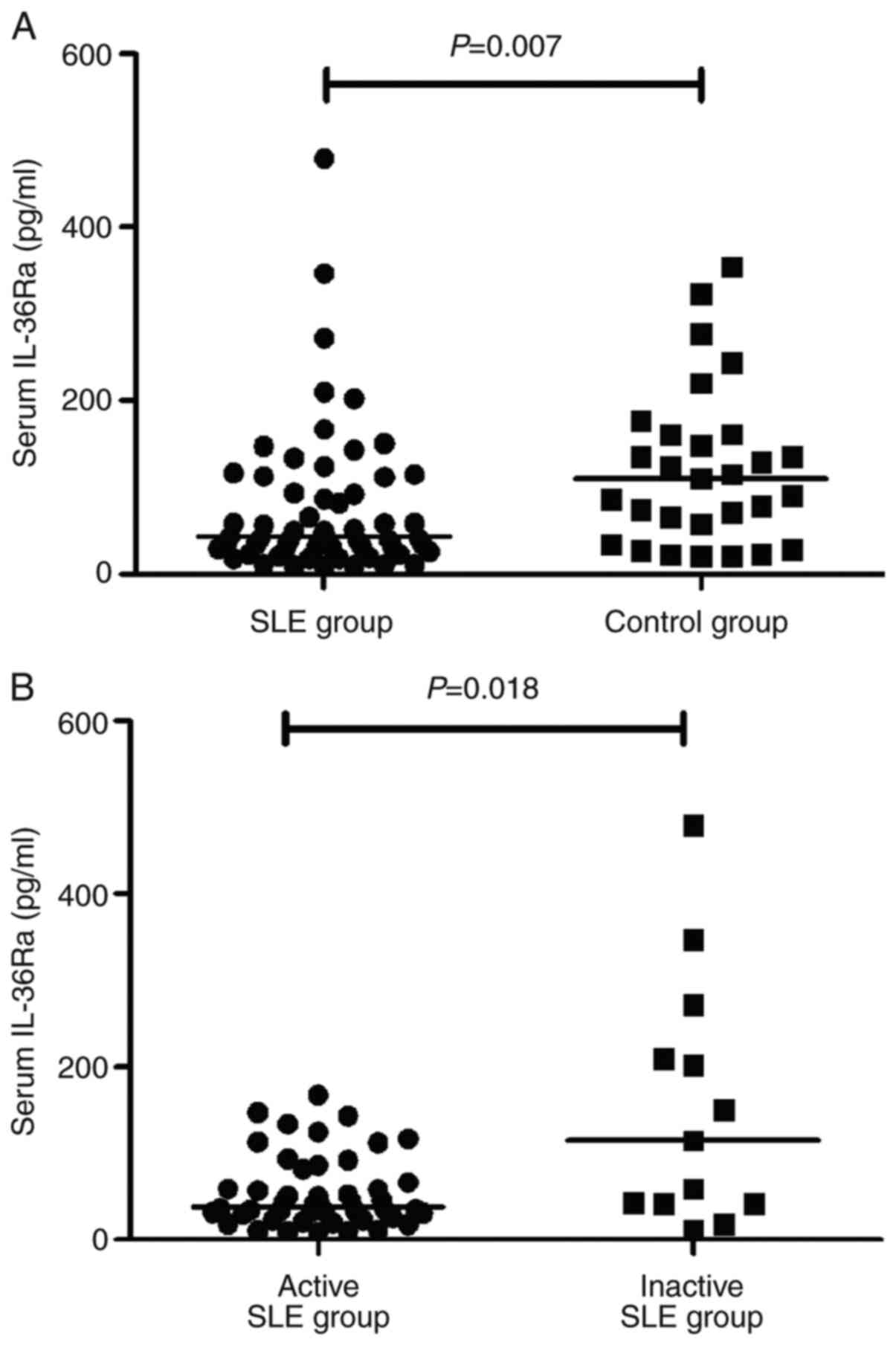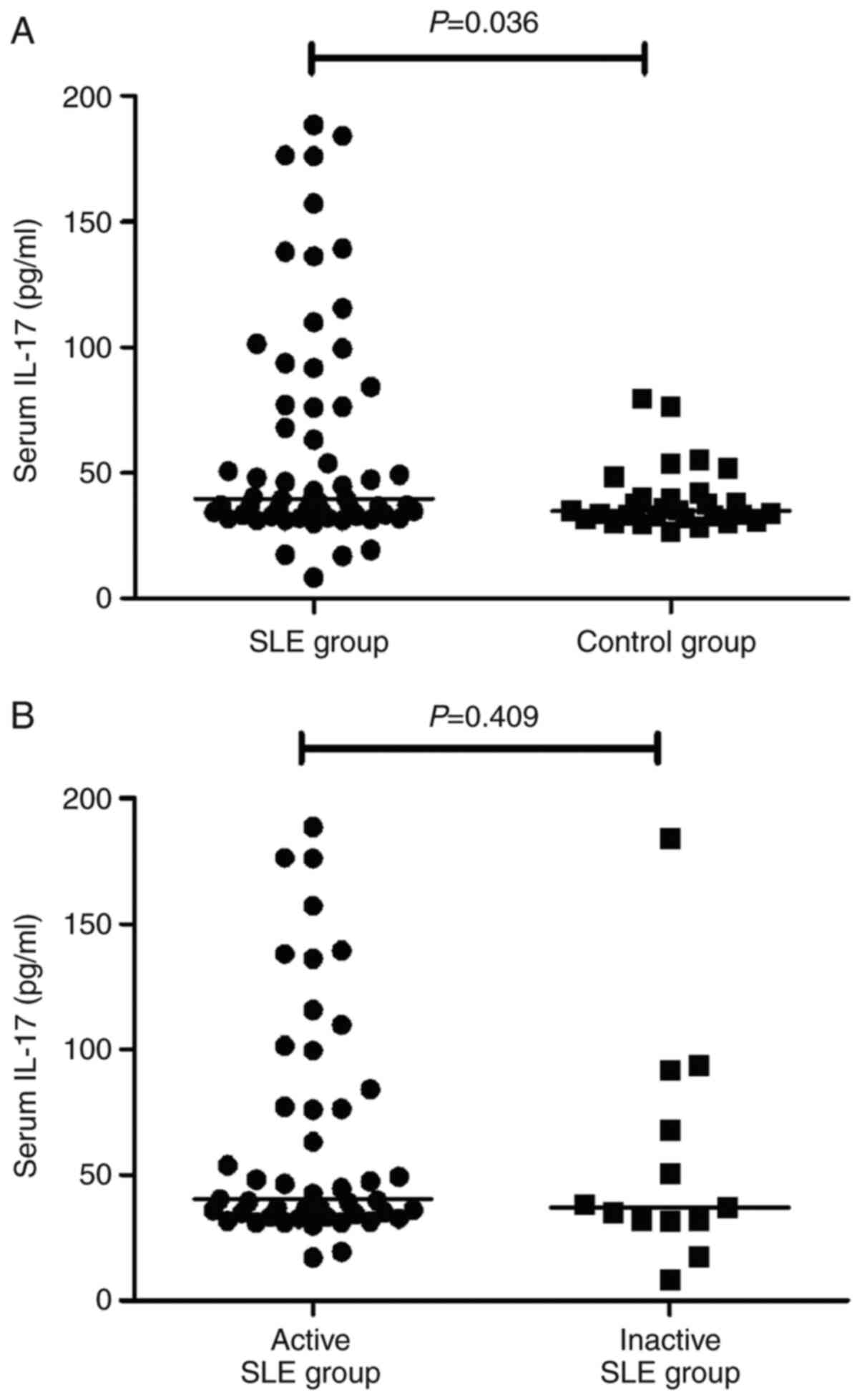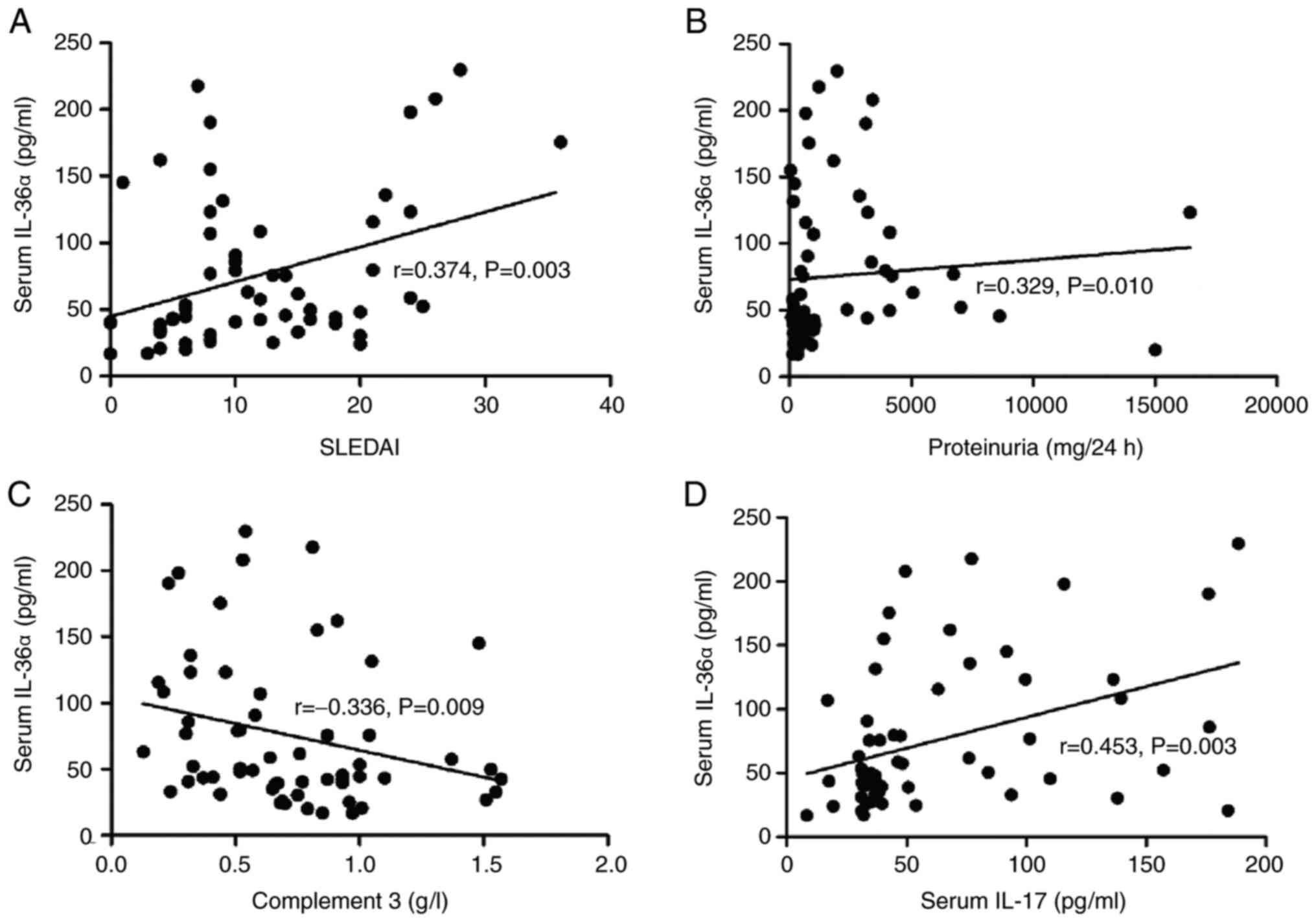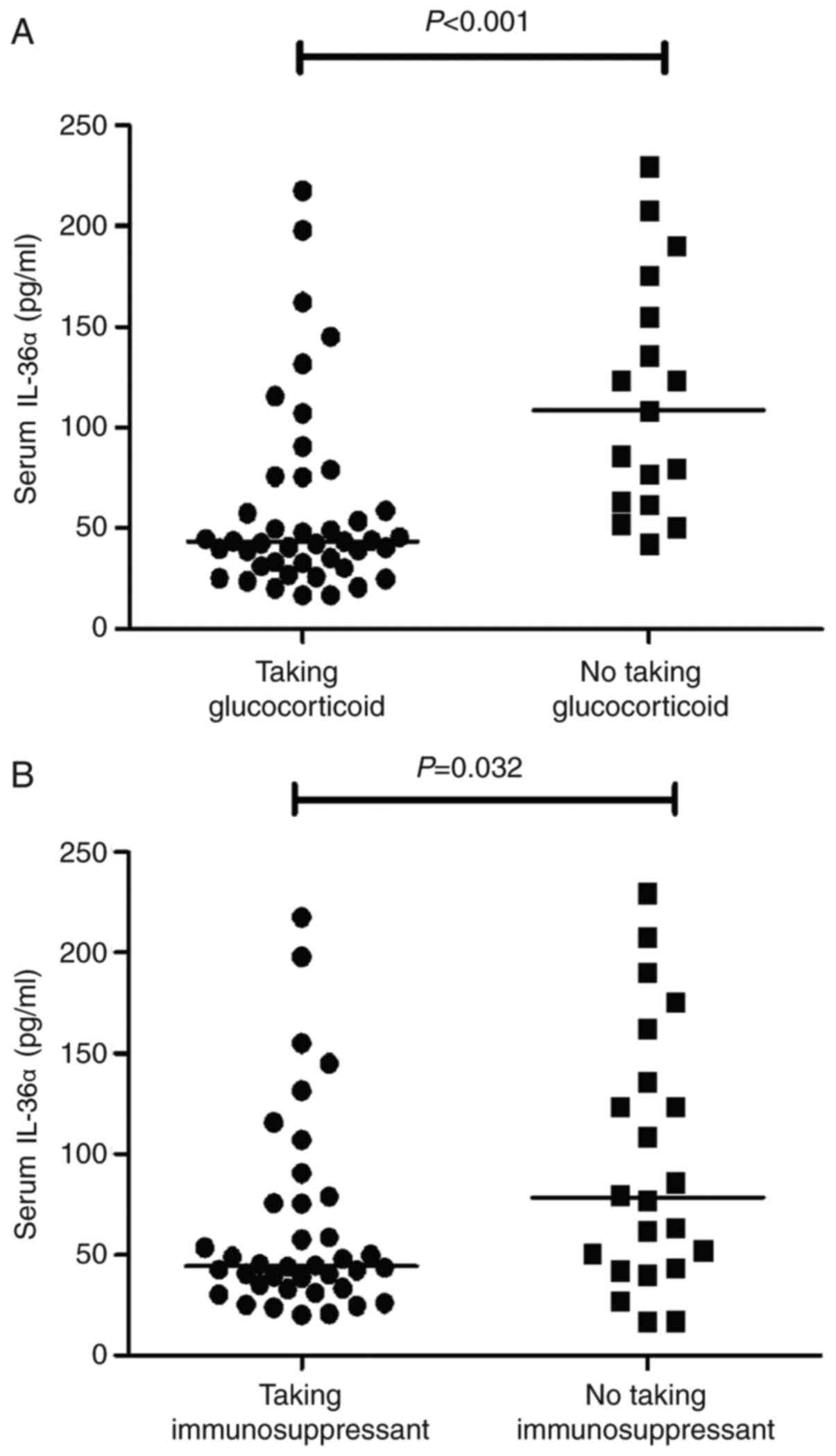|
1
|
van de Veerdonk FL and Netea MG: New
insights in the immunobiology of IL-1 family members. Front
Immunol. 4(167)2013.PubMed/NCBI View Article : Google Scholar
|
|
2
|
Tortola L, Rosenwald E, Abel B, Blumberg
H, Schäfer M, Coyle AJ, Renauld JC, Werner S, Kisielow J and Kopf
M: Psoriasiform dermatitis is driven by IL-36-mediated
DC-keratinocyte crosstalk. J Clin Invest. 122:3965–3976.
2012.PubMed/NCBI View
Article : Google Scholar
|
|
3
|
Ciccia F, Accardo-Palumbo A, Alessandro R,
Alessandri C, Priori R, Guggino G, Raimondo S, Carubbi F, Valesini
G, Giacomelli R, et al: Interleukin-36α axis is modulated in
patients with primary Sjögren's syndrome. Clin Exp Immunol.
181:230–238. 2015.PubMed/NCBI View Article : Google Scholar
|
|
4
|
Perry D, Peck AB, Carcamo WC, Morel L and
Nguyen CQ: The current concept of T(h)17 cells and their expanding
role in systemic lupus erythematosus. Arthritis (Egypt).
2011(810649)2011.PubMed/NCBI View Article : Google Scholar
|
|
5
|
Chen XQ, Yu YC, Deng HH, Sun JZ, Dai Z, Wu
YW and Yang M: Plasma IL-17A is increased in new-onset SLE patients
and associated with disease activity. J Clin Immunol. 30:221–225.
2010.PubMed/NCBI View Article : Google Scholar
|
|
6
|
Yang J, Chu Y, Yang X, Gao D, Zhu L, Yang
X, Wan L and Li M: Th17 and natural Treg cell population dynamics
in systemic lupus erythematosus. Arthritis Rheum. 60:1472–1483.
2009.PubMed/NCBI View Article : Google Scholar
|
|
7
|
Gresnigt MS and van de Veerdonk FL:
Biology of IL-36 cytokines and their role in disease. Semin
Immunol. 25:458–465. 2013.PubMed/NCBI View Article : Google Scholar
|
|
8
|
Gresnigt MS, Rösler B, Jacobs CW, Becker
KL, Joosten LA, van der Meer JW, Netea MG, Dinarello CA and van de
Veerdonk FL: The IL-36 receptor pathway regulates Aspergillus
fumigatus-induced Th1 and Th17 responses. Eur J Immunol.
43:416–426. 2013.PubMed/NCBI View Article : Google Scholar
|
|
9
|
Carrier Y, Ma HL, Ramon HE, Napierata L,
Small C, O'Toole M, Young DA, Fouser LA, Nickerson-Nutter C,
Collins M, et al: Inter-regulation of Th17 cytokines and the IL-36
cytokines in vitro and in vivo: Implications in psoriasis
pathogenesis. J Invest Dermatol. 131:2428–2437. 2011.PubMed/NCBI View Article : Google Scholar
|
|
10
|
Chi HH, Hua KF, Lin YC, Chu CL, Hsieh CY,
Hsu YJ, Ka SM, Tsai YL, Liu FC and Chen A: IL-36 signaling
facilitates activation of the NLRP3 inflammasome and IL-23/IL-17
axis in renal inflammation and fibrosis. J Am Soc Nephrol.
28:2022–2037. 2017.PubMed/NCBI View Article : Google Scholar
|
|
11
|
Mai SZ, Li CJ, Xie XY, Xiong H, Xu M, Zeng
FQ, Guo Q and Han YF: Increased serum IL-36α and IL-36γ levels in
patients with systemic lupus erythematosus: Association with
disease activity and arthritis. Int Immunopharmacol. 58:103–108.
2018.PubMed/NCBI View Article : Google Scholar
|
|
12
|
Chu M, Wong CK, Cai Z, Dong J, Jiao D, Kam
NW, Lam CW and Tam LS: Elevated expression and pro-inflammatory
activity of IL-36 in patients with systemic lupus erythematosus.
Molecules. 20:19588–19604. 2015.PubMed/NCBI View Article : Google Scholar
|
|
13
|
Hochberg MC: Updating the American College
of Rheumatology revised criteria for the classification of systemic
lupus erythematosus. Arthritis Rheum. 40(1725)1997.PubMed/NCBI View Article : Google Scholar
|
|
14
|
Bombardier C, Gladman DD, Urowitz MB,
Caron D and Chang CH: Derivation of the SLEDAI. A disease activity
index for lupus patients. The Committee on Prognosis Studies in
SLE. Arthritis Rheum. 35:630–640. 1992.PubMed/NCBI View Article : Google Scholar
|
|
15
|
Gandevia B and Tovell A: Declaration Of
Helsinki. Med J Aust. 2:320–321. 1964.PubMed/NCBI
|
|
16
|
Towne JE, Garka KE, Renshaw BR, Virca GD
and Sims JE: Interleukin (IL)-1F6, IL-1F8, and IL-1F9 signal
through IL-1Rrp2 and IL-1RAcP to activate the pathway leading to
NF-kappaB and MAPKs. J Biol Chem. 279:13677–13688. 2004.PubMed/NCBI View Article : Google Scholar
|
|
17
|
Frey S, Derer A, Messbacher ME, Baeten DL,
Bugatti S, Montecucco C, Schett G and Hueber AJ: The novel cytokine
interleukin-36α is expressed in psoriatic and rheumatoid arthritis
synovium. Ann Rheum Dis. 72:1569–1574. 2013.PubMed/NCBI View Article : Google Scholar
|
|
18
|
Debets R, Timans JC, Homey B, Zurawski S,
Sana TR, Lo S, Wagner J, Edwards G, Clifford T, Menon S, et al: Two
novel IL-1 family members, IL-1 delta and IL-1 epsilon, function as
an antagonist and agonist of NF-kappa B activation through the
orphan IL-1 receptor-related protein 2. J Immunol. 167:1440–1446.
2001.PubMed/NCBI View Article : Google Scholar
|
|
19
|
Zhou X, Krueger JG, Kao MC, Lee E, Du F,
Menter A, Wong WH and Bowcock AM: Novel mechanisms of T-cell and
dendritic cell activation revealed by profiling of psoriasis on the
63,100-element oligonucleotide array. Physiol Genomics. 13:69–78.
2003.PubMed/NCBI View Article : Google Scholar
|
|
20
|
Blumberg H, Dinh H, Trueblood ES,
Pretorius J, Kugler D, Weng N, Kanaly ST, Towne JE, Willis CR,
Kuechle MK, et al: Opposing activities of two novel members of the
IL-1 ligand family regulate skin inflammation. J Exp Med.
204:2603–2614. 2007.PubMed/NCBI View Article : Google Scholar
|
|
21
|
Qiu F, Song L, Yang N and Li X:
Glucocorticoid downregulates expression of IL-12 family cytokines
in systemic lupus erythematosus patients. Lupus. 22:1011–1016.
2013.PubMed/NCBI View Article : Google Scholar
|
|
22
|
Song L, Qiu F, Fan Y, Ding F, Liu H, Shu
Q, Liu W and Li X: Glucocorticoid regulates interleukin-37 in
systemic lupus erythematosus. J Clin Immunol. 33:111–117.
2013.PubMed/NCBI View Article : Google Scholar
|
|
23
|
Zhang M, Xu WD, Zhu Y, Wen PF, Leng RX,
Pan HF and Ye DQ: Serum levels of cytokines in systemic lupus
erythematosus: Association study in a Chinese population. Z
Rheumatol. 73:277–280. 2013.PubMed/NCBI View Article : Google Scholar
|
|
24
|
Maddur MS, Miossec P, Kaveri SV and Bayry
J: Th17 cells: Biology, pathogenesis of autoimmune and inflammatory
diseases, and therapeutic strategies. Am J Pathol. 181:8–18.
2012.PubMed/NCBI View Article : Google Scholar
|
|
25
|
Ichii O, Otsuka S, Sasaki N, Yabuki A,
Ohta H, Takiguchi M, Hashimoto Y, Endoh D and Kon Y: Local
overexpression of interleukin-1 family, member 6 relates to the
development of tubulointerstitial lesions. Lab Invest. 90:459–475.
2010.PubMed/NCBI View Article : Google Scholar
|
|
26
|
Wong CK, Lit LC, Tam LS, Li EK, Wong PT
and Lam CW: Hyperproduction of IL-23 and IL-17 in patients with
systemic lupus erythematosus: Implications for Th17-mediated
inflammation in auto-immunity. Clin Immunol. 127:385–393.
2008.PubMed/NCBI View Article : Google Scholar
|
|
27
|
Wong CK, Ho CY, Li EK and Lam CW:
Elevation of proinflammatory cytokine (IL-18, IL-17, IL-12) and Th2
cytokine (IL-4) concentrations in patients with systemic lupus
erythematosus. Lupus. 9:589–593. 2000.PubMed/NCBI View Article : Google Scholar
|
|
28
|
Veldhoen M, Hocking RJ, Atkins CJ,
Locksley RM and Stockinger B: TGFbeta in the context of an
inflammatory cytokine milieu supports de novo differentiation of
IL-17-producing T cells. Immunity. 24:179–189. 2006.PubMed/NCBI View Article : Google Scholar
|
|
29
|
Nalbandian A, Crispín JC and Tsokos GC:
Interleukin-17 and systemic lupus erythematosus: Current concepts.
Clin Exp Immunol. 157:209–215. 2009.PubMed/NCBI View Article : Google Scholar
|
|
30
|
Bettelli E, Carrier Y, Gao W, Korn T,
Strom TB, Oukka M, Weiner HL and Kuchroo VK: Reciprocal
developmental pathways for the generation of pathogenic effector
TH17 and regulatory T cells. Nature. 441:235–238. 2006.PubMed/NCBI View Article : Google Scholar
|
|
31
|
Mangan PR, Harrington LE, O'Quinn DB,
Helms WS, Bullard DC, Elson CO, Hatton RD, Wahl SM, Schoeb TR and
Weaver CT: Transforming growth factor-beta induces development of
the T(H)17 lineage. Nature. 441:231–234. 2006.PubMed/NCBI View Article : Google Scholar
|
|
32
|
Nicklin MJ: Finally, function for
‘IL-1Fs’. Blood. 118:5713–5714. 2011.PubMed/NCBI View Article : Google Scholar
|
|
33
|
Towne JE, Renshaw BR, Douangpanya J,
Lipsky BP, Shen M, Gabel CA and Sims JE: Interleukin-36 (IL-36)
ligands require processing for full agonist (IL-36α, IL-36β, and
IL-36γ) or antagonist (IL-36Ra) activity. J Biol Chem.
286:42594–42602. 2011.PubMed/NCBI View Article : Google Scholar
|















